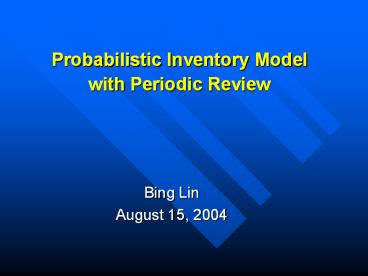Probabilistic Inventory Model with Periodic Review - PowerPoint PPT Presentation
1 / 17
Title:
Probabilistic Inventory Model with Periodic Review
Description:
Holding costs and shortage costs are charged at the end of each period. ... Level of inventory on hand at the start of period t ... – PowerPoint PPT presentation
Number of Views:1002
Avg rating:3.0/5.0
Title: Probabilistic Inventory Model with Periodic Review
1
Probabilistic Inventory Model with Periodic
Review
- Bing Lin
- August 15, 2004
2
- Introduction
- Assumption Notation Model Formulations
- Optimal Policies of Inventory Models
- Proof of the Optimal Policy
- Discussions
- Reference
3
Introduction
- Wilsons Economic order Quantity (EOQ) 1930s
- Bellmans Dynamic Programming in 1950s
- Arrow et. al. (1951,1958) and Bellman
et.al.(1955) Introduction of dynamic programming
in inventory management - Scarf (1960) for the proof of optimality of (s,
S) policy in finite horizon - Iglehart(1963) proves the optimality of (s, S)
policy in infinite horizon - Federgruen and Zipkin (1986) prove the optimality
of modified bask stock policy - Shaoxiang and Lambrecht (1996) and Shaoxiang
(2004) propose the X-Y band structure (partially
optimal).
4
Notation Assumption Model Formulations
Scarf (1960) Iglehart (1963)
- Cumulative demands in successive periods are
assumed to form a sequence of i.i.d random
variables which have continuous distribution
function. - Three costs incurred in each period. Ordering
costs c( ), holding cost h( ) and shortage cost - Holding costs and shortage costs are charged at
the end of each period. Delivery is
instantaneous. - Demands are fully backlogged.
5
Notation Assumption Model Formulations
Scarf (1960) Iglehart (1963)
K and c are positive constants
6
Notation Assumption Model Formulations
Wagner (1972)
- The Sequence of event within any period t
- Ordering decision
- Delivery of order due in from period t-?
- Customer demand
Level of inventory on hand at the start of
period t
Level of inventory on hand plus on order at the
start of period t prior to the ordering decision
amount ordered in period t
7
Notation Assumption Model Formulations
For the backlog case of Wagner (1972)
Q denotes the cumulative demand over ?
.
Suppose we already know the probability
distributions
Probability that the cumulative demand is Q
Recursively computed according to the convolution
formula
8
Notation Assumption Model Formulations
If the demand distribution is i.i.d, then
The ?-fold convolution of p(q)
Example
Probability distribution p(2)0.2 and p(3)0.8
.
When ?2
When ?3
9
Notation Assumption Model Formulations
Finite Horizon Model Wagner(1972)
inventory holding and shortage cost incurred in
period t when there is k units to meet the demand
q in period t.
When ?0
When ?gt0
probability of demand q in period t ?
probability of total cumulative demand Q in
period t ?
10
Notation Assumption Model Formulations
Finite Horizon Model Wagner(1972)
Period 2
Period T
T?
period1
?-1
11
Notation Assumption Model Formulations
Finite Horizon Model Wagner(1972)
. Due to the constant
multiplies the whole expressions dropped for
simplicity.
The dynamic programming formulation appropriate
to finding optimal policies that minimize the
above expectation formula is
12
Proof of the optimality of (s S) Policy
The dynamic programming of this inventory system
with periodic review is
(s S) policy
The key of the proof is the inductive approach.
First, prove g1(y) is K-convex. Assume gn-1(y) is
K-convex. Then try to prove gn(y) is K-convex.
13
Proof of the optimality of (s S) Policy
X is current inventory level Y is the
order-up-to inventory level
Sn is the minimizing value of y and sn is the
least value such that
14
Proof of the optimality of (s S) Policy
Definition f (x) is K-convex if
or
(1) 0-convexity is equivalent to ordinary
convexity (2) If f (x) is K-convex, then f (x
h) is K-convex for all h (3) If f and g are
K-convex and M-convex, respectively, then
is -convex,
aand ßare positive
15
Proof of the optimality of (s S) Policy
To show the optimality of the (s S) policy,
firstly show gn(y) is K-convex
This inequality implies that the optimal policy
is (s S)
16
Proof of the optimality of (s S) Policy
The proof of K-convexity of gn1(y) need to prove
that fn(x) is K-convex
As the consequence of K-convexity of gn(y), the
optimal policy of n-period is (s S). Then
The proof of K-convexity of fn(x). We distinguish
three cases
Case 1
Linear function is K-convex and gn(x) is
K-convex. Their sum is K-convex
17
Proof of the optimality of (s S) Policy
Case 2
Using the above then
Case 3

